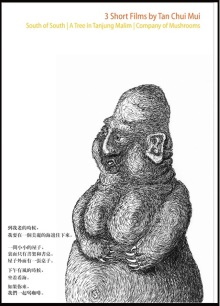
My wife wanted to visit Kluang last week to attend a small arts event organized by local Chinese writers and artists. In particular, she wanted to listen in on a couple of talks, the first one featuring a trio of local writers and the second one by Tan Chui Mui. I hadn’t heard of her before this but she is apparently considered one of Malaysian’s greatest rising directorial talents, especially as a woman, by dint of winning a bunch of international film awards.
In any case, her talk turned out to be pretty bad. Maybe it’s because she isn’t much of a public speaker but she kept harping on the single subject that commercial success shouldn’t mean that much to a director, so much so that the audience gently mocked her for it. She even ignored the host’s attempts to steer the talk onto other topics. Still, after the talk my wife decided to buy a DVD collection of her short films and I confess that I was also curious about how well her work matches against that of international-standard directors. This one is comprised of A Tree in Tanjung Malim, Company of Mushrooms and South of South. All three added together amount to a running time of only slightly more than an hour.
The first one is the longest and apparently the most highly acclaimed. It’s also the one with the fewest number of performers ain it: a young female student meeting and talking with a slightly older man. She’s naive and clearly has a crush on him, but he’s jaded, world weary and encourages her to be practical. My wife liked it because there’s some poetic sensibility in it but I found it slow, pretentious and too obvious. I ended up liking the other two quite a bit more. One is about a gathering of male friend talking cock over a meal, though perhaps this is just a case of me being a male myself and being able to empathize more with them, hypocrisies and all. The last one is the shortest, just a bit over ten minutes, but it’s only one with any truly beautiful cinematography. It’s a portrait of a Chinese fishing family on the coast of Kuantan, with the backdrop being an influx of refugees from Vietnam. It’s probably my favorite of the three. Its shortness means that it’s denser than the others with many different elements in play and its setting of a seaside house feels authentic with many objects in the background to make the scene look interesting. Compare this to how bare-bones and plain the supposed restaurant looks.
Unfortunately, the production value falls very much into the realm of student films. Part of this is undoubtedly due to the very limited budget, resulting in flaws like uneven lighting and poorly mixed sound. But I can’t say that the composition or editing are much good either and you don’t need money to get these things done right. In the restaurant scene with the four friends for example, the audience’s view of one of them is frequently blocked by another person’s head, even when he is speaking dialogue. Changes in camera perspective are also awkwardly handled. Just when I thought that they were going for a static camera, Taiwan-style, they suddenly cut to a closer framing. But then why do these shots for some lines of dialogue but not others? Just the fact that these cuts are being noticed by the audience should be a mark of failure. My wife suggested that she might be better off as a scriptwriter instead of a director since she clearly has intriguing ideas. Coincidentally enough, when asked about her future plans during her talk in Kluang, she indicated that she intends to concentrate on writing in the near future.
The short film format makes it hard to know the quality of her work in feature films. Since she has directed at least two full length films, we should probably watch at least one of them some time down the road. But I don’t think this quite matches the quality of even short films that are internationally of note. Perhaps more money and more experience would improve her work. For now, I think she has potential and bears watching but saying that this the best that Malaysia can offer is still kind of embarrassing.